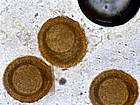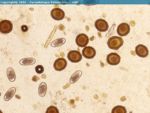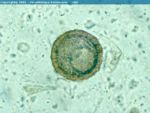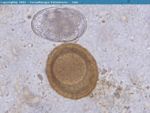PARASCARIS EQUORUM
General
- Ascarid, small intestine.
- Mostly in young horses, especially foals <6months old.
Morphology
- Stout worms, up to 50cm long.
- Three large lips around mouth.
Life-Cycle
- Direct.
- Infection - ingestion of embryonated egg (L2).
- Egg (100µm diameter, brown, thick pitted shell).
- Larvae → hepatotracheal migration (liver → heart → lungs → intestine, 3weeks).
- Prepatent period = 10-12weeks.
Pathogenicity
- Larvae - eosinophilic tracts and haemorrhages in liver and lungs. Clinically, latter may lead to cough and nasal discharge.
- Adult worms - may cause unthriftiness, weight loss; impaction and intestinal perforation rarely.
Epidemiology
High Fecundity of Female Parascaris:
- Infected foal may pass millions of eggs per day.
Resistance of Eggs in Environment:
- Thick, pitted shell ensures prolonged survival (>1year).
- Sticky outer shell aids passive spread.
Susceptible Animals:
- Foals (<4months) - transmission from one year's foals to the next, infection normally occurring during the first month of life.
- Adult horses - few worms only (carriers?).
Control
- Regular anthelmintic treatment.
- Remove faeces from paddocks - collect every 2weeks (takes 2weeks to reach L2 stage).



